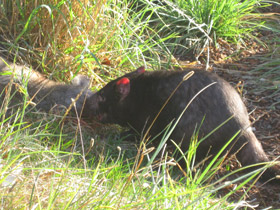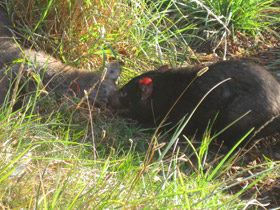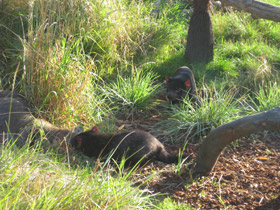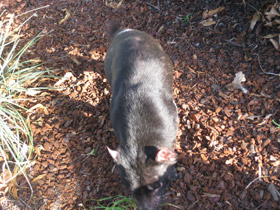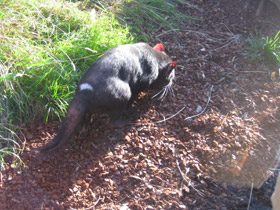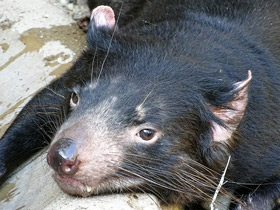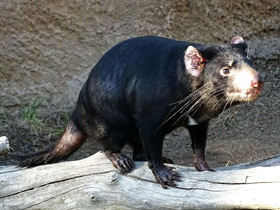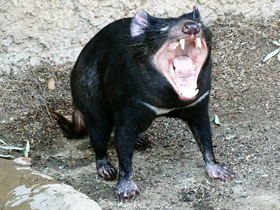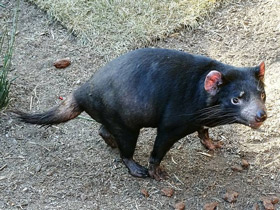The Tasmanian devil or purinina (Sarcophilus harrisii)
The Tasmanian devil (Sarcophilus harrisii) (palawa kani: purinina) is a carnivorous marsupial of the family Dasyuridae. It was formerly present across mainland Australia, but became extinct there around 3,500 years ago. The size of a small dog, the Tasmanian devil became the largest carnivorous marsupial in the world following the extinction of the thylacine in 1936. It is related to quolls, and distantly related to the thylacine. It is characterised by its stocky and muscular build, black fur, pungent odour, extremely loud and disturbing screech, keen sense of smell, and ferocity when feeding. The Tasmanian devil's large head and neck allow it to generate among the strongest bites per unit body mass of any extant predatory land mammal. It hunts prey and scavenges on carrion.
Description
Sarcophilus harrisii is a species of dasyuromorph marsupial of the family Dasyuridae. It is currently found only in the wild on the island of Tasmania in southern mainland Australia.
The appearance of Sarcophilus harrisii fully justifies its gruesome name: it has a powerful, stocky body covered in black fur with white markings, muscular legs, a fat, bald tail that accumulates fat, small pink ears, a disproportionately massive head and a huge mouth with sharp teeth capable of crushing large bones. In addition, Sarcophilus harrisii is noted for its extraordinary aggressiveness, ferocity and, despite its small size (body length 50-80 cm and weight 8-10 kg), its remarkable strength, which allows it to attack large animals. The voice of Sarcophilus harrisii is not pleasant either, described as a "whiny grunt followed by a hoarse cough or, if disturbed, a low, shrill growl".
Habitat and lifestyle
This strange animal is only found on the island of Tasmania. Sarcophilus harrisii is a very clean animal; not only does it bathe regularly, but it also likes to use water, folding its forelegs into a bucket and washing its face. These marsupials swim well and cross rivers easily, can climb trees and like to bask in the sun (although they prefer to hunt at night). During the day, Sarcophilus harrisii hide in shelters, where they make nests of bark, leaves and grass. They are very voracious and feed on small and medium-sized mammals and birds, as well as insects, crustaceans, snakes, amphibians, edible roots and plant tubers. Using their superior sense of smell, Sarcophilus harrisii constantly seek out and eat carrion of all kinds, from fish to fallen sheep and cows, preferring meat that is already decayed, rotten and wormy.
Reproduction
Sarcophilus harrisii mates in early spring. Surprisingly, even their mating is a demonstration of aggression, and after 3 days the female will expel the male completely. Gestation lasts about 20 days, after which 20 to 30 young are born, of which no more than four survive, the first to crawl into the marsupium and manage to attach themselves to four teats. Terrible as it is, the rest of the young are eaten by the female. The young of Sarcophilus harrisii grow very fast: at 90 days they are completely covered with hair, at the same time as their eyes open. In the fourth month, the adult devils leave the pouch, but their mother feeds them with milk for another 5-6 months. Many young females begin breeding at the age of one year, however, the life expectancy of these animals is very short, only 7-8 years.
Threats to livelihoods
Sarcophilus harrisii used to be considered a threat to livestock by farmers and was hunted. Subsequently, the species was officially protected and its numbers stabilised. It is now on the IUCN Red List as an endangered species. At present, the most important threat to Sarcophilus harrisii is the "devil's face tumour disease", or DFTD. The mortality rate of this disease is 100% (within 12-18 months).
First observed in 1996, Devil facial tumour disease (DFTD) has devastated the population of this species, with an estimated reduction of more than 60% of individuals between 1996 and 2010,120 and more than 80% between 1996 and 2016. The west coast and northwest of the state are the only areas where devils remain free of the disease. Infected devils die within months after the cancer becomes visible.
It can kill 20-50% of the marsupial population in different years, mainly in the eastern part of the island.

















